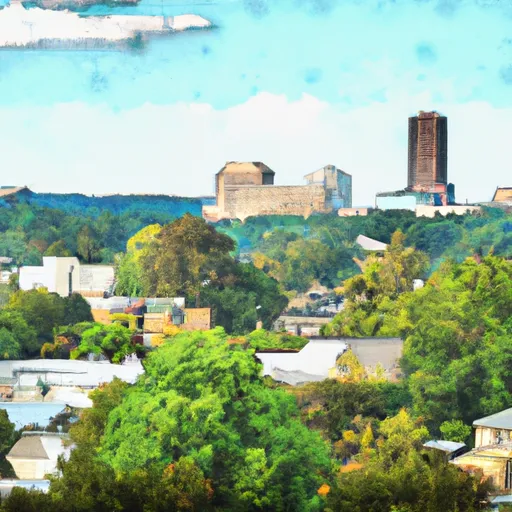-
 Snoflo Premium
Snoflo Premium
Get unlimited access to all our content
With no Ad interruptions! - Start Your Free Trial Login with existing account
Washington
Eden Index
Climate
9.7
•
Recreation
3.2
•
Community
2.3
•
Safeguard
5.6/10

Washington, Georgia, located in Wilkes County, offers a pleasant subtropical climate with mild winters and hot, humid summers. The average temperature ranges from the low 40s°F (5°C) in winter to the mid-90s°F (35°C) in summer. Rainfall is well-distributed throughout the year, with an annual average of about 47 inches (1200 mm).
The town is surrounded by beautiful natural features, including several creeks and small rivers that contribute to its hydrology. The Little River, Kettle Creek, and South Fork Broad River are notable water bodies in the area. These waterways provide opportunities for fishing, canoeing, and kayaking. Anglers can try their luck catching various species, including bass, catfish, and crappie.
Outdoor enthusiasts will find plenty of recreational activities in Washington. The town features several parks and green spaces, such as Callaway Park and Pope's Ferry Landing, providing opportunities for picnicking, walking, and enjoying nature. Additionally, nearby Clarks Hill Lake offers boating, swimming, and camping options. Hiking and wildlife observation can be enjoyed in nearby state parks, like Elijah Clark State Park and Hard Labor Creek State Park.
With its inviting climate, diverse hydrology, and range of outdoor activities, Washington, Georgia is a great destination for nature lovers and adventure seekers.
What is the Eden Index?
The Snoflo Eden Index serves as a comprehensive rating system for regions, evaluating their desirability through a holistic assessment of climate health, outdoor recreation opportunities, and natural disaster risk, acknowledging the profound impact of these factors on livability and well-being.
Climate Health Indicator (CHI): 9.7
Washington receives approximately
1146mm of rain per year,
with humidity levels near 79%
and air temperatures averaging around
17°C.
Washington has a plant hardyness factor of
8, meaning
plants and agriculture in this region tend to thrive here all year round.
By considering the ideal temperature range, reliable water supplies, clean air, and stable seasonal rain or snowpacks, the Climate Health Indicator (CHI) underscores the significance of a healthy climate as the foundation for quality living.
A healthy climate is paramount for ensuring a high quality of life and livability in a region, fostering both physical well-being and environmental harmony. This can be characterized by ideal temperatures, reliable access to water supplies, clean air, and consistent seasonal rain or snowpacks.
Weather Forecast
Streamflow Conditions
Savannah
Area Rivers
Savannah
Snowpack Depths
Savannah
Reservoir Storage Capacity
Savannah
Groundwater Levels
Recreational Opportunity Index (ROI): 3.2
The Recreational Opportunity Index (ROI) recognizes the value of outdoor recreational options, such as parks, hiking trails, camping sites, and fishing spots, while acknowledging that climate plays a pivotal role in ensuring the comfort and consistency of these experiences.
Access to outdoor recreational opportunities, encompassing activities such as parks, hiking, camping, and fishing, is crucial for overall well-being, and the climate plays a pivotal role in enabling and enhancing these experiences, ensuring that individuals can engage in nature-based activities comfortably and consistently.
Camping Areas
| Campground | Campsites | Reservations | Toilets | Showers | Elevation |
|---|---|---|---|---|---|
| Hamburg State Park | None | 353 ft | |||
| Big Hart - Strom Thurmond Lake | 31 | 367 ft | |||
| Little Ocmulgee State Park | None | 202 ft | |||
| A.H. Stephens State Park | None | 618 ft | |||
| Bobby Brown State Park | None | 403 ft | |||
| Richard B. Russell State Park | None | 598 ft | |||
| Calhoun Falls State Rec Area | 100 | 575 ft | |||
| Hesters Ferry - Strom Thurmond Lake | None | 417 ft | |||
| Mount Carmel - Strom Thurmond Lake | 40 | 380 ft | |||
| Broad River - Strom Thurmond Lake | None | 362 ft |
Nearby Ski Areas
Catastrophe Safeguard Index (CSI):
The Catastrophe Safeguard Index (CSI) recognizes that natural disaster risk, encompassing floods, fires, hurricanes, and tornadoes, can drastically affect safety and the overall appeal of an area.
The level of natural disaster risk in a region significantly affects safety and the overall livability, with climate change amplifying these risks by potentially increasing the frequency and intensity of events like floods, fires, hurricanes, and tornadoes, thereby posing substantial challenges to community resilience and well-being.
Community Resilience Indicator (CRI): 2.3
The Community Resilience Indicator (CRI) recognizes that education, healthcare, and socioeconomics are crucial to the well-being of a region. The CRI acknowledges the profound impact of these elements on residents' overall quality of life. By evaluating educational resources, healthcare accessibility, and economic inclusivity, the index captures the essential aspects that contribute to a thriving community, fostering resident satisfaction, equity, and social cohesion.

